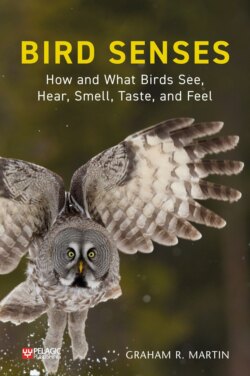Читать книгу Bird Senses - Graham R. Martin - Страница 10
На сайте Литреса книга снята с продажи.
Chapter 1 Senses and sensory ecology
ОглавлениеA Peregrine leaves its lookout in pursuit of a dove that it detected from more than a kilometre away. In under two minutes the dove is held firmly in the falcon’s talons. An Oilbird flies to its nest ledge inside a cave that is so deep that no light enters, darkness is total. In moonlight a Red Knot probes its bill through the squelchy surface of estuary mud, and without even lifting its bill detects and ingests a buried worm. A Great Tit searches through a wood and locates an infestation of caterpillars on a particular tree. The presence of the caterpillars is detected well before the Great Tit sees them.
All of these are brilliant examples of bird senses in action. Each describes an instance of a bird using particular information to control one of its key behaviours. Included in these examples are the detection of prey at a great distance, precise seizure of a target by the feet or bill, location of a foraging site, mobility in the dark. Each bird’s survival requires that these actions are executed many times during its lifetime, and each action must be executed with high accuracy, both in time and in space.
These examples were chosen because each depends on information gathered primarily by a different sense. Vision in the case of the Peregrine, hearing in the Oilbird, touch and taste in the Knot, and olfaction (the sense of smell) in the Great Tit. While information from one sense underpins each of these particular behaviours, these birds must also rely on information from a suite of different senses in order to conduct themselves safely during their everyday lives (Figure 1.1).
FIGURE 1.1 Clockwise from top left: a Peregrine Falco peregrinus, an Oilbird Steatornis caripensis, a Red Knot Calidris canutus, and a Great Tit Parus major. Each species exploits information from a different sense to guide some its key behaviours. (Photograph of Great Tit by Francis C. Franklin [CC-BY-SA-3.0].)
In all instances this different information is integrated and interpreted by the birds’ brains in a seamless fashion. We may focus our attention on the pursuit flight of the Peregrine, and wonder how it achieves such an impressive performance, but in reality the bird is moving rapidly from the execution of one task to another. No sooner has the prey been spotted than it is time to line up for its seizure, and the prey is grabbed with impeccable timing. We can even think of these birds as simultaneous multitaskers, for example looking out for predators or a competitor while searching for food, and each different task requires different information.
Equally important is the range of environmental conditions in which these four birds carry out their key tasks – from total darkness to bright sunlight, from open habitats to the structural complexity of a forest. We could also choose examples of birds foraging in the open airspace, or finding food hidden on hard and soft surfaces, or beneath surfaces, or through the surface of water, or underwater at both shallow and deep depths, so deep that daylight hardly penetrates. Each habitat type presents different sensory and informational challenges which the birds must meet in order to live out their daily lives.
Every bird species is special. By definition every species is unique, and much of what attracts our attention to particular birds is the fact that they are able to execute tasks that others cannot. It is this diversity of behaviour, as much as diversity of appearance, that makes watching and studying birds so rewarding.
At one site, on one day, even at the same moment, we can see birds of different species acting in very different ways. Each is a specialist, and it is the parade of these specialisms that is behind much of the allure of watching birds. But while we can readily understand how obvious structural adaptations, particularly of their wings, bills, and feet, can allow different species to execute particular actions, it is easy to overlook the fact that those wings, bills, and feet must be guided accurately.
There is no value in having a tool if it cannot be adequately controlled. A hammer that cannot be brought down accurately to hit a nail is useless. The hammer needs precision guidance in both time and space. In the same way, a long bill for grabbing a fish, or a short bill for seizing a seed, or a foot for grabbing another bird out of the air, are useless if they cannot be controlled and brought exactly to the target with precise timing. Each bill, foot, and wing requires specialised information to guide it to the right place and to get there at the right time. Actions need information, and different actions need different information.
